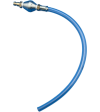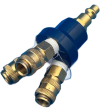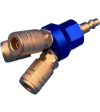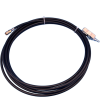
In the world of HVAC maintenance, duct cleaning is a critical task that ensures the efficiency and longevity of heating and cooling systems. As a homeowner or a professional cleaner, understanding the tools involved in duct cleaning, specifically whips and nozzles, is crucial. These components are the unsung heroes of the duct cleaning process, allowing for the removal of dust, debris, and allergens that compromise air quality and system performance.
In this comprehensive guide, we’ll delve into the nuances of selecting the right whips and nozzles for duct cleaning. We’ll explore historical context, current trends, and potential future implications, backed by real-world scenarios that illustrate their importance.
Table of Contents
- Understanding Duct Cleaning
- The Importance of Whips and Nozzles
- Types of Whips and Nozzles
- Factors to Consider When Choosing Whips and Nozzles
- Historical Context and Evolution
- Current Trends in Duct Cleaning Equipment
- Future Implications for Duct Cleaning Tools
- Real-World Scenarios and Case Studies
- Conclusion
- FAQs
Understanding Duct Cleaning
Duct cleaning involves the thorough cleaning of various heating and cooling system components, including supply and return air ducts, grills, diffusers, heat exchangers, and more. The primary goal is to improve indoor air quality and enhance system efficiency.
Common Problems Addressed by Duct Cleaning:- Accumulation of dust and debris
- Mold growth due to moisture
- Pest infestations
- Unpleasant odors
Regular duct cleaning can prevent health issues, improve energy efficiency, and extend the lifespan of HVAC systems. The choice of tools, specifically whips and nozzles, can significantly influence the effectiveness of the cleaning process.
The Importance of Whips and Nozzles
Whips and nozzles are essential components of duct cleaning equipment. They are designed to dislodge and remove debris from the inner surfaces of ducts. Choosing the right type can drastically impact the cleaning efficiency and outcome.
Whips
Whips are flexible rods with multiple tendrils, used to agitate and dislodge debris. They are particularly effective for:
- Reaching Tight Spaces: Their flexibility allows them to navigate through complex ductwork.
- Agitating Stubborn Debris: The rapid spinning motion can break apart caked-on dirt and dust.
Nozzles
Nozzles direct the airflow in a controlled manner and are often used in conjunction with high-powered vacuums. They help in:
- Focusing Airflow: Directing air to specific areas needing more attention.
- Enhanced Suction: Maximizing the vacuum’s efficiency in debris removal.
Types of Whips and Nozzles
Choosing the right whip or nozzle depends on various factors, including the type of duct system, the extent of contamination, and personal preferences. Here’s a closer look at the different types available:
Types of Whips
Pneumatic Whips:
- Operate using compressed air.
- Ideal for heavy-duty cleaning.
Rotary Whips:
- Use a rotating motion to agitate debris.
- Best for large duct systems with heavy contamination.
Manual Whips:
- Require physical manipulation.
- Suitable for small-scale or targeted cleaning.
Types of Nozzles
Jet Nozzles:
- Provide a concentrated burst of air.
- Effective in dislodging stubborn debris.
Brush Nozzles:
- Combine airflow with physical brushing.
- Useful for cleaning ducts with a significant buildup.
Variable Nozzles:
- Allow for adjustable airflow.
- Offer versatility for different cleaning needs.
Factors to Consider When Choosing Whips and Nozzles
When selecting whips and nozzles, consider the following factors to ensure optimal cleaning results:
1. Duct Material and Size
- Material: Different materials (e.g., metal, fiberglass) require specific tools to avoid damage.
- Size: The diameter and length of the ducts will influence the type and size of tools needed.
2. Type of Contaminants
- Dust and Dirt: Basic whips and nozzles may suffice.
- Mold: Requires specialized equipment and possibly chemical treatments.
- Pests: May necessitate stronger tools and additional pest control measures.
3. Cleaning Frequency
- Frequent cleaning might require more durable and versatile tools.
- Infrequent cleaning may demand high-powered equipment to handle heavy buildup.
4. Budget Considerations
- Cost vs. Quality: Higher-end tools offer better durability and efficiency.
- Long-term Investment: Investing in quality equipment can save money over time by reducing cleaning frequency and extending HVAC lifespan.
Historical Context and Evolution
Duct cleaning, as a professional service, has evolved significantly over the years. Initially, basic tools and manual labor were the primary methods. However, with advancements in technology and increased awareness of indoor air quality, the industry has seen substantial changes.
Early Days
- Manual Cleaning: Involved simple brushes and cloths.
- Limited Awareness: Indoor air quality was not a primary concern.
Technological Advancements
- Introduction of Pneumatic and Rotary Tools: Revolutionized the efficiency of duct cleaning.
- Focus on Air Quality: Increased demand for regular duct maintenance.
Modern Innovations
- Automated Systems: Robotics and AI-driven solutions are emerging.
- Eco-Friendly Options: Environmentally conscious choices are becoming popular.
Current Trends in Duct Cleaning Equipment
The duct cleaning industry is witnessing several trends that are shaping the selection and use of whips and nozzles:
1. Eco-Friendly Solutions
- Biodegradable Materials: Tools made from sustainable materials.
- Chemical-Free Cleaning: Preference for methods that avoid harmful chemicals.
2. Smart Technology Integration
- IoT-Enabled Devices: Smart sensors that provide real-time data and analytics.
- AI Assistance: Automated systems that enhance precision and efficiency.
3. Customization and Versatility
- Tailored Solutions: Equipment designed for specific duct systems and contamination types.
- Modular Tools: Components that can be easily replaced or upgraded.
Future Implications for Duct Cleaning Tools
As technology advances, the future of duct cleaning tools looks promising. Here are some potential implications:
1. Increased Automation
- Robotic Cleaners: Devices that can autonomously navigate and clean duct systems.
- Automated Monitoring: Systems that alert homeowners or technicians when cleaning is required.
2. Enhanced Precision
- Laser-Guided Tools: For pinpoint accuracy in cleaning.
- AI and Machine Learning: Predictive maintenance and optimization of cleaning schedules.
3. Sustainable Practices
- Green Technology: Continued focus on reducing environmental impact.
- Energy Efficiency: Tools designed to optimize energy use during cleaning.
Real-World Scenarios and Case Studies
Scenario 1: Residential Duct Cleaning
In a typical suburban home, residents noticed an increase in allergies and a persistent musty odor. Upon inspection, it was discovered that the ductwork was harboring mold and dust. Using pneumatic whips and brush nozzles, a professional cleaning service was able to effectively remove the contaminants, significantly improving air quality and comfort.
Scenario 2: Commercial Building Maintenance
A large office building was experiencing inconsistent heating and cooling. An inspection revealed blocked ducts due to accumulated debris. Rotary whips and jet nozzles were employed to clear the blockages, restoring proper airflow and system efficiency.
Scenario 3: Industrial Facility Upkeep
An industrial facility with extensive ductwork required regular maintenance to prevent downtime. By investing in high-quality rotary whips and variable nozzles, the facility was able to maintain a clean and efficient system, reducing operational costs and improving worker safety.
Conclusion
Choosing the right whips and nozzles for duct cleaning is a crucial decision that impacts the effectiveness of the cleaning process and the overall health of HVAC systems. By understanding the types of tools available, considering various factors, and keeping abreast of industry trends, homeowners and professionals can make informed choices that lead to cleaner air and more efficient systems.
As the industry continues to evolve, embracing new technologies and sustainable practices will be essential. Whether you’re a do-it-yourself enthusiast or a seasoned professional, the right tools can make all the difference in achieving optimal indoor air quality.
FAQs
Why is duct cleaning important?
- It improves indoor air quality, enhances HVAC efficiency, and prevents health issues by removing dust, debris, and allergens.
What are the main types of whips and nozzles?
- Whips include pneumatic, rotary, and manual types, while nozzles include jet, brush, and variable types.
How often should ducts be cleaned?
- It depends on various factors, but generally every 3-5 years. Homes with pets or allergies may require more frequent cleaning.
Can I clean ducts myself, or should I hire a professional?
- While basic cleaning can be a DIY project, professional services are recommended for thorough cleaning and complex systems.
What are the benefits of using eco-friendly cleaning tools?
- They reduce environmental impact, avoid harmful chemicals, and often improve the efficiency and safety of the cleaning process.












Write a comment